SanDisk Extreme Pro SSD (240GB, 480GB & 960GB) Review: The Fastest Just Got Faster
by Kristian Vättö on June 16, 2014 4:00 PM EST- Posted in
- Storage
- SSDs
- SanDisk
- Extreme Pro
Random Read/Write Speed
The four corners of SSD performance are as follows: random read, random write, sequential read and sequential write speed. Random accesses are generally small in size, while sequential accesses tend to be larger and thus we have the four Iometer tests we use in all of our reviews.
Our first test writes 4KB in a completely random pattern over an 8GB space of the drive to simulate the sort of random access that you'd see on an OS drive (even this is more stressful than a normal desktop user would see). We perform three concurrent IOs and run the test for 3 minutes. The results reported are in average MB/s over the entire time.
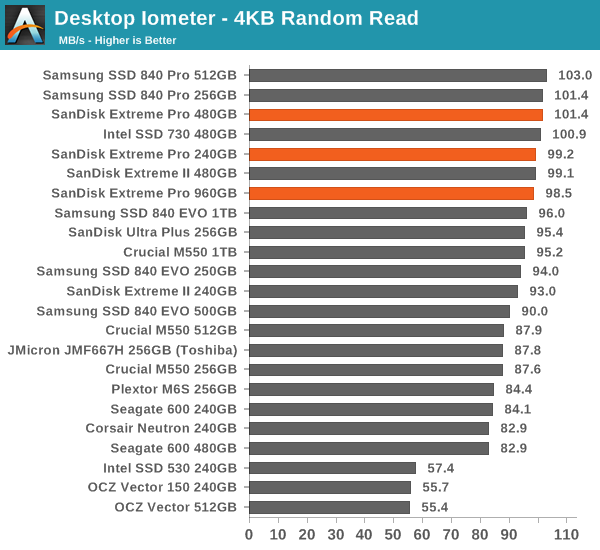
The random read performance is great, which was expected when coming from the Extreme II.
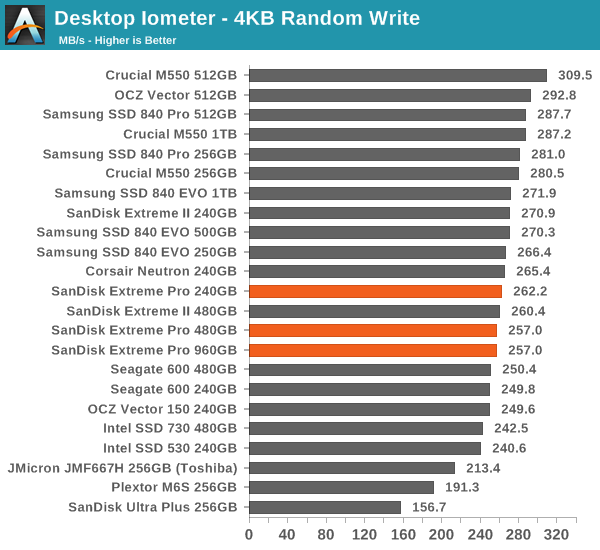

Random write performance, on the other hand, is only mediocre, although it's consistency that matters and not necessarily the peak performance. It seems that drives with high consistency do not have as good peak performance because the Extreme Pro, Vector 150 and SSD 730 are in the middle, whereas the 840 EVO and M550 lead the pack despite their relatively poor IO consistency. I would take consistency over ~10% better peak performance, though.
Sequential Read/Write Speed
To measure sequential performance we run a 1 minute long 128KB sequential test over the entire span of the drive at a queue depth of 1. The results reported are in average MB/s over the entire test length.
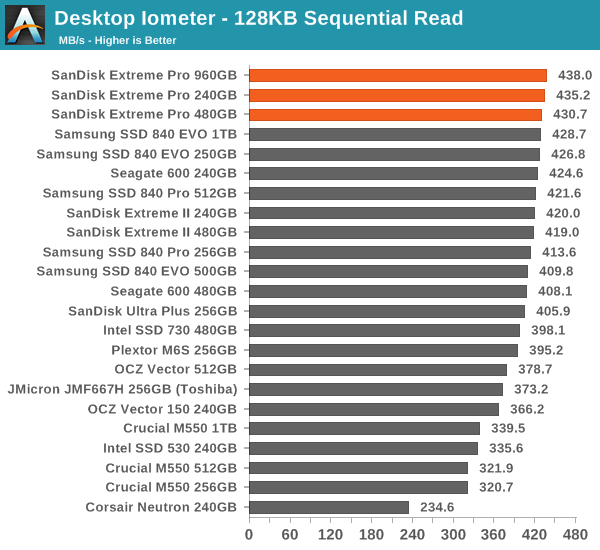
Sequential performance is definitely good. I think the high read speed is one of the reasons why the Extreme Pro did so well in the 2013 Storage Bench because both the SSD 730 and Vector 150 are noticeably slower.
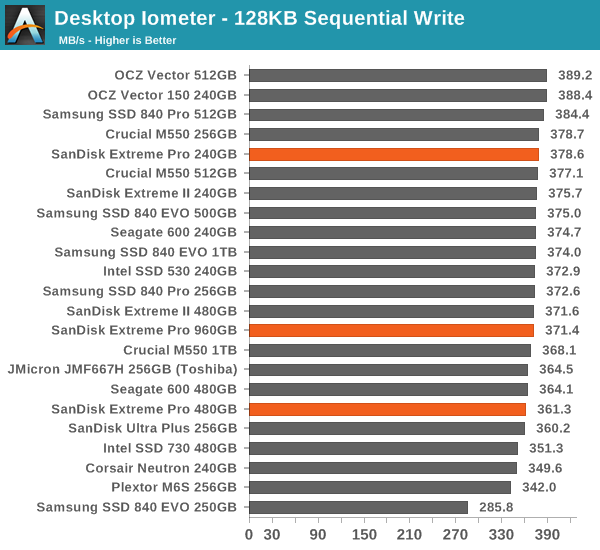
AS-SSD Incompressible Sequential Read/Write Performance
The AS-SSD sequential benchmark uses incompressible data for all of its transfers. The result is a pretty big reduction in sequential write speed on SandForce based controllers.
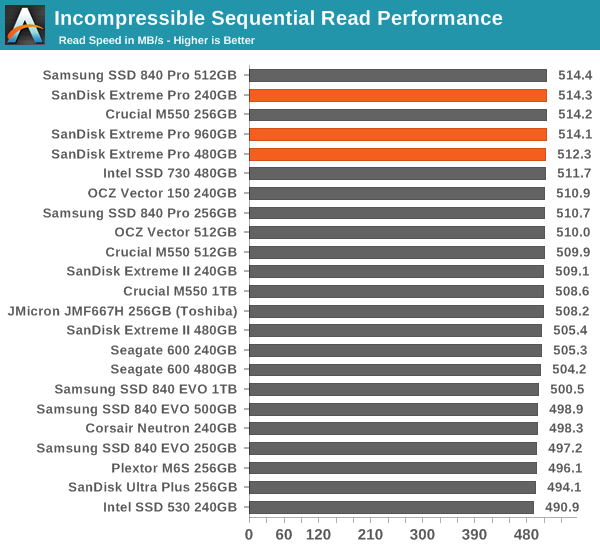
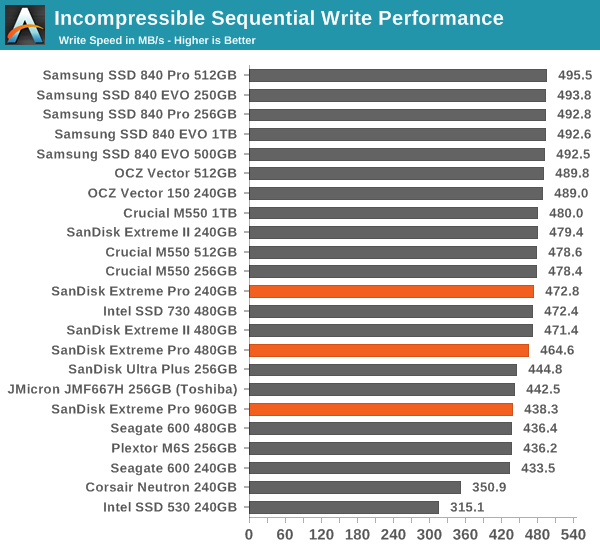










85 Comments
View All Comments
vaayu64 - Tuesday, June 17, 2014 - link
Look for the review here on anandtech....Shiitaki - Monday, June 16, 2014 - link
Actually, Samsung sells the 840 EVO up to 1TB in a msata.apertotes - Monday, June 16, 2014 - link
Well, I am just a simple architect, and probably I am not representative of Anandtech userbase, but, why do you feel hardware encryption is so important? Am I missing something? Should I be worried that my hard drives are not encrypted?r3loaded - Monday, June 16, 2014 - link
I'm wondering about the focus on encryption too. I have a Samsung Evo in my Sandy Bridge desktop machine and it supposedly supports this Opal hardware encryption. Trouble is, I have no idea how to enable it. Apparently, I can set a disk password but I see no option for that in my computer's firmware. Someone mentioned enabling BitLocker in Windows 8.1, but I get an error message saying my system doesn't have a TPM chip. I have zero idea how to go about enabling it on Linux, but I suppose dm-crypt for software encryption should work just fine.andychow - Monday, June 16, 2014 - link
I don't get it either. If your file system is not encrypted, then simply plugin the ssd to another machine and get all the data. If your file system is encrypted, then what does it matter if the hardware is encrypted? I think they just offer it because it costs them almost nothing to have a hardware encryption chip, and enterprises like buzzwords.@reloaded, you don't have to enable it, it's always on. The password is on the controller, if you destroy that, the data could not be recuperated. But why would you destroy the controller and not the rest of the drive is beyond me.
I personally don't see the point.
chiechien - Tuesday, June 17, 2014 - link
Your BIOS has to support disk passwords, and you have to enable it. For drives with hardware encryption, the ATA/disk/whatever password has to be known to get at the encryption key, otherwise it's just left at some default that every machine can read.Kristian Vättö - Tuesday, June 17, 2014 - link
Hardware encryption means that the encryption is done by the hardware rather than software. The benefit is that because it's done at the device-level, it doesn't consume the host CPU like software encryption and it's more secure.While SSDs often encrypt all data that is written to them, you still have to enable encryption from the host to ensure that the data can't be accessed by a third party. Otherwise the SSD think that any machine (and user) is allowed to access the data.
thomas-hrb - Monday, June 16, 2014 - link
Good point, personally encryption at the hardware level is not important to me. I find common sense and protection of property out weighs the continuous management overhead of encryption keys especially for a developer like me who regularly and repeatedly reformats partitions.Especially when working with cloudbased/corporate share online only storage. I do wonder however, I have a samsung 840 pro (256GIB version) I have 2 vertex4's (256 GiB version). I have on many occasions rebuilt/reformatted and transplanted my SSD's from one machine to the next. I don't know if I have to explicitly enable/disable the feature on the SSD, but IMHO, if I could easily read the SSD contents simply by moving it to another computer, then what ever encryption is on the drive is simply not effective.
chiechien - Tuesday, June 17, 2014 - link
The Samsung (and probably the Vertex) encrypts (just by the nature of how it works) everything that is written to the drive as a matter of course. Unless you set an ATA password in your BIOS, though, the password/encryption key/whatever is left 'blank' or default or whatever, so it is readable by any other motherboard. If you set an ATA password, though, that changes the encryption key, you will probably have to wipe the drive to enable it, and then the drive will not be readable in another system unless you also configure it for ATA passwords as well, and then type it in.hojnikb - Monday, June 16, 2014 - link
I wonder why Sandisk didn't went with marvel *89 controller ?